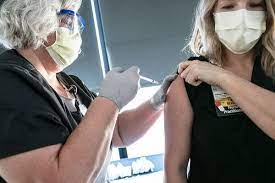The COVID-19 pandemic led to the biggest one-year drop in U.S. births in nearly 50 years. But a new study shows not every state was equally affected.
Researchers found some states experienced steep decreases in fertility while other saw little change, according to the report published last week in the peer-reviewed journal Human Reproductions.
They discovered fluctuating fertility rates in some states were more strongly linked to demographic, economic and political factors rather than COVID-19 cases, suggesting family planning could have been partly stunted by consequences of the pandemic rather than the disease itself.
“This new study offers a striking portrait of the shifting landscape of American family life,” said Brad Wilcox, professor of sociology and director of the National Marriage Project at the University of Virginia, who is unaffiliated with the study.
U.S. births had been declining for more than a decade since before COVID-19, but they dropped 4% from 2019 to 2020, according to the Centers for Diseases Control and Prevention. Births increased by 1% from 2020 to 2021 but haven’t recovered to pre-pandemic rates.
COVID waves and US fertility rates
Study authors from the New York University Grossman School of Medicine analyzed data from the CDC, the 2020 U.S. Census, and 2021 population estimates from the University of Virginia. They then calculated fertility rates after each COVID-19 wave.
They found that the severity of the wave in some states appeared to have little effect on fertility rates in 2020.
While New York experienced a massive drop in fertility rates after the first wave – plunging to roughly 76 fewer monthly births per 100,000 women compared with pre-pandemic rates – states like Idaho, Montana and Utah experienced a boost of up to 56 births each month per 100,000 women.
The COVID-19 impact on fertility rates “was a lot stronger in the states that had an earlier hit – the states that got hit in the spring like the Northwest and Northeast,” said the study’s senior author, Linda Kahn, assistant professor in the departments of pediatrics and population health at New York University Grossman School of Medicine.
The South got hit a few months later, and the effect on fertility rates was not that strong, she said.
Red-blue ‘divide in family formation’
The research team took a step further and examined other factors that could have influenced fertility rates during the first two COVID-19 waves.
Study authors analyzed states’ political leaning and social distancing unit, which tracked changes in people’s mobility using cellphone data. They found states with stronger social distancing responses that leaned politically liberal saw steeper fertility rate declines after the first wave of the pandemic.
For example, politically liberal places like New York and Washington, D.C., had the highest social distancing indexes and the lowest fertility rates, while conservative states like Idaho and Montana had the lowest social distancing indexes and the highest fertility rates.
“Heading into COVID, we already saw that fertility was higher in red America than in blue America,” Wilcox said. “But COVID seems to have augmented this divide in family formation, with blue states seeing much greater declines in fertility than red states.”

